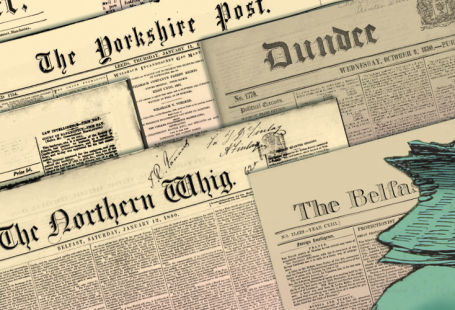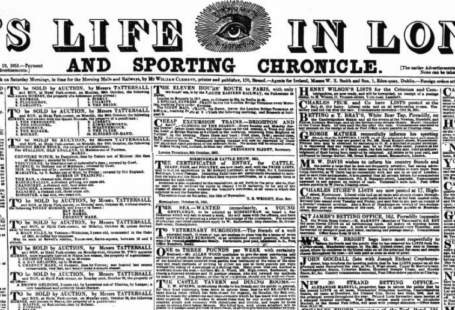We are delighted to introduce Edmund King to The BNA blog. Ed was Head of the British Library Newspaper Library and Newspaper Librarian from 1999 until retirement from his role earlier this year. Ed will be writing several guest posts here on The British Newspaper Archive blog in the coming months. We’re really looking forward to reading more.
Let’s begin with Ed’s first BNA blog post, recalling the life and work of Robert Stevenson, entitled, ‘Saving seamen’s lives’ . . .
Of those prominent in saving seamen’s lives, Robert Stevenson (1772-1850) is a worthy candidate. His death on 12 July 1850 was noted in the Manchester Times – Wednesday 17 July 1850, p.7. col.6. “He was the sole designer and sole executioner of the celebrated Bell Rock Lighthouse.”
Perhaps the most significant contribution he made to the safety of ships and seamen in Scotland was the construction of the Bell Rock lighthouse, in 1807-1811. Lives at sea had always been lost as a result of storms. That of 1799 off the East Coast of Scotland resulted in seventy vessels lost, with most of their crews. (Caledonian Mercury, Monday 29 June, 1807, and p.3 col.2.) View the full article for FREE here.
After this, renewed energy was made to design and install a lighthouse to prevent such losses; attention focused upon Bell Rock, eleven miles south of Arbroath, and one of the most dangerous reefs for ships. Robert Stevenson submitted his proposals to the Commissioners for Northern Lights, and was appointed Assistant Engineer for its construction.
The obstacles to building were daunting: stormy weather was frequent; work could only be undertaken in summer months and at low tide. The story of the work was followed by a number of newspapers, in particular the Caledonian Mercury. Reported in their issue of Saturday 25 August 1810 (p.3 col.4), there was a letter written by “…a gentleman engaged in the undertaking”. It was reported that the lighthouse foundation stone was laid on Sunday 10th July 1808. The lighthouse was to be 100 feet high and 42 feet in diameter at its base. The writer went on: “… The foundation course is on a level with low water springtides, the sea accordingly, … seldom rises more than 16 feet of the building; yet, in the month of June last [1809] when the lighthouse was 70 feet high, the workmen were actually driven off the walls by the sea spray.”
Caledonian Mercury, Saturday 25 August 1810 (p.3 col.4)
Click here to view the full article for FREE!
Despite these difficulties, construction was complete by the end of 1810, and the Commissioners announced that the light from the lighthouse would commence from the 1st February 1811. (Caledonian Mercury Saturday 5 January 1811 p. 3 col. 4)
The light would appear: “… alternately of a bright yellow and deep red colour, by means of coloured glass.” It was to be visible for 12 miles out into the German ~Ocean, “… at so great a distance as to assist in preventing the recurrence of such dismal mistakes as have this winter happened in what seafaring people term Berwick Bay.” The article concluded: “We cannot help adding, that it is owing to the laudable zeal of the Commissioners having been duly seconded by the enterprize [sic] and indefatigable perseverance of their engineer, Mr Stevenson, that our Scottish Eddistone Lighthouse has been completed, a whole year sooner than we could possibly have anticipated.”. Please click here to view the Caledonian Mercury article for FREE.
Robert Stevenson wrote and published his work: An account of Bell Rock light-house with a circumstantial detail of the operations carried on during the progress of its erection, in 1824. An advertisement placed (probably by the publisher A. Constable) in the Leeds Intelligencer of 27 May 1824, p.1 states: “Embellished with numerous engravings and a frontispiece from a drawing by Turner… As only 240 copies of this work are printed for sale, early application for copies will be necessary.”
Leeds Intelligencer of 27 May 1824, p.1 – View the article in full here.
As engineer to the Northern Lighthouse Board from 1808 to 1843, Robert Stevenson designed and constructed at least eighteen lighthouses. Reports of these appear regularly in newspapers : progress on the Isle of May lighthouse (Caledonian Mercury Thursday 1 February 1816 p.3 col. 2)
And the Dunnet Head Lighthouse – “Notice to Mariners”
Belfast Newsletter Tuesday 30 August 1831 p.3. col. 4.
Robert Stevenson’s sons – Alan, David, and Thomas all worked in the family business. The endeavour to improve the safety of seamen and of their ships continued. David and Thomas were also engineers to the Northern Lighthouse Board in the years 1855-1882. They designed some 28 beacons and 30 lighthouses. What of Thomas’s only son? He was none other than Robert Louis Stevenson, who inherited his father’s talent for writing. By 1871, Robert Louis gave up his early training in engineering, and, partly as a result of poor health, he rejected any further interest in the family engineering enterprise, going on to write famous novels as Kidnapped and the Strange case of Dr Jeykll and Mr Hyde, both published in 1886. Amongst his many poems, the Light-Keeper evokes memories of his early training in lights and lighthouses:
The clear bell chimes: the clockworks strain:
The turning lenses flash and pass,
Frame turning within glittering frame
With frosty gleam of moving glass:
Unseen by me, each dusky hour
The sea-waves welter up the tower
Or in the ebb subside again;
And ever and anon all night,
Drawn from afar by charm of light,
A sea-bird beats against the pane.
Ed King
October 2012
Further reading:
Oxford Dictionary of National Biography
Bathurst, Bella. The lighthouse Stevensons. 1999.
Scots Sites: http://www.scotsites.co.uk/ebooks/thelightkeeper.htm
Many thanks to Ed for this fantastic post. We look forward to reading more in the coming months!
The British Newspaper Archive team




